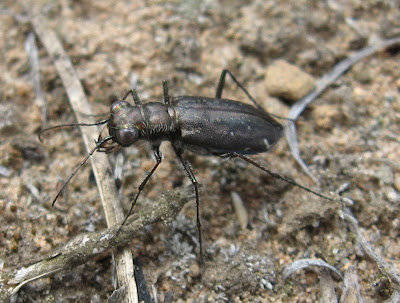Not a very coleopterological title, perhaps "A Scuttle of Beetles" would have been better in that respect. Tiger Beetles, however, are not known for their ability to scuttle. The larvae are indeed ambush hunters, hiding in burrows with only their heads exposed, hoping to grab a passing meal with their crescent-shaped jaws. Should they latch onto something too strong to handle they have hooks on their abdomens which serve to anchor them in their burrow until their digestive enzymes overcome their prey. And the equally predacious adults are agile runners and superb fliers, feeding on caterpillars, grasshoppers, spiders and whatever other arthropods they can catch.
Despite their competence as hunters tiger beetles are by no means apex predators – they also need those long legs and strong wings to evade birds, toads, robber flies and dragonflies. And speed isn't enough to escape parasites such as mites, wasps and even certain species of bee flies. (Sometimes I just sit and observe predators, prey, parasitoids and parasites interacting, eating and competing with one another ... and wonder how anything survives ...)
At roughly 12 mm in length the metallic blue-green Six-Spotted Tiger Beetle (Cicindela sexguttata) is of average size, but definitely stands alone among our local tiger beetles in terms of color.

A front view showing the pronged, interlocking jaws ... an insect unlucky enough to caught in them isn't getting out again.
The Big Sand Tiger Beetle (Cicindela formosa generosa) is about 18 to 20 mm long, making it the largest tiger beetle I've encountered to date – it makes an audibly droning sound when taking flight.
A portrait taken in the shade. At first glance the patterning which camouflages tiger beetles so well may appear dull, but up close the light and dark brown resolves into a myriad of brilliant colors.
At the opposite end of the size spectrum, only about 10 mm in length and relatively drab compared to its cousins, is the Punctured Tiger Beetle (Cicindela punctulata).
On Page #84 of the Peterson Field Guide to
Beetles (Houghton Mifflin Company) the author, Richard E. White, observes how "the light markings on the elytra of many Cincindela species ... provide a good example of evolutionary development of color pattern." – specifically noting (among other species, which I unfortunately don’t have photos of) C. scutellaris, C. repanda, C. tranquebarica. It is interesting to note that C. sexguttata, C. formosa and C. punctulata, pictured above, also share similar or attenuated versions of the basic pattern.
The aptly named Festive Tiger Beetle (Cicindela scutellaris) makes up for the lack of decorative patterning on its backside with gaudy iridescent colors. This tiger beetle and the following two species are all about 12 mm long.
Tiger beetles can be opportunists. Although quite capable of doing so this beetle didn't hunt for its meal – it stole the grasshopper from a Tachysphex wasp that had stung and paralyzed it to feed its own offspring.
Like other tiger beetles, the Bronzed Tiger Beetle (Cicindela repanda) has a penchant for sunshine, heat, and barren terrain, however, it's more likely to be found hunting on the sandy beach along the lake shoreline.
Always look twice! At first I mistook this Oblique-lined Tiger Beetle (Cicindela tranquebarica) for a Bronzed Tiger Beetle. But compare the first markings on the elytra of these two insects – the diagonally oriented, rather than c-shaped marking, earned this tiger beetle its name.
One "tiger" I haven't had luck acquiring an image of, very similar to the two above, is the Hairy-necked Tiger Beetle (Cicindela hirticollis). But then again, a couple of years ago I had no idea there were so many species of tiger beetles in our area. That's the great thing about getting out there in the field and observing and photographing nature ... there's always something new to learn, and never a dull or boring moment ...
















